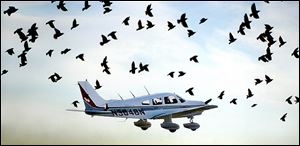
Study: Birds bad at gauging speed of objects
Flight instinct triggered by proximity of vehicles, planes, not how fast they’re moving
1/11/2015
Birds take flight after being disturbed by a plane. Research done near Sandusky suggests that birds don’t factor in an object’s speed when deciding how to to avoid a collision.
Birds may fail to avoid being hit by automobiles — and, with sometimes more disastrous results, airplanes — because they don’t perceive approaching vehicles’ speed very well, according to a freshly published study for which research was done at a laboratory near Sandusky.
No birds were injured in the experiments done at the U.S. Department of Agriculture’s National Wildlife Research Center lab, which used brown-headed cowbirds trapped and then released after each video-based test.
What the researchers found, according to the report published Wednesday in the Proceedings B journal of the Royal Society of London, was that the birds took flight when they perceived an approaching vehicle to be a particular distance away, regardless of its speed.
“You would think a really large, noisy vehicle approaching them would be sufficient stimulus for them to fly away, but it doesn’t happen that way,” said Travis DeVault, one of two research-center scientists who, along with researchers from Purdue and Indiana State universities, led the study.
A lot of prior research into animal collisions, Mr. DeVault noted, has focused on “mitigation methods,” such as building turtle tunnels under roadways and designing airports to reduce exposure to birds or other wildlife.
“We wanted to back up and look at it in a more fundamental way,” he said.
At higher vehicle speeds, the researchers found in their simulations using videos shown in an indoor lab, the cowbirds didn’t take off soon enough and would have been struck had the experiment used real vehicles instead. That conclusion was drawn based on separate, field observations of how long it takes a cowbird to fly 3 meters, the approximate width of a typical road lane: 0.8 second.
The videos, filmed on the grounds of NASA’s Plum Brook Station, where the research center also is located, showed a pickup truck approaching on a straight road toward the experimental chamber at varying speeds.
The truck was introduced after about 11 minutes during which the video showed the empty road. It started from a little more than three-quarters of a mile away and approached a camera mounted on the pavement at a steady speed before passing over it.
The experimental birds did appear to become alert to the potential threat well before they were in danger even at higher speeds, according to the study report, but did not actually flee until the “approaching” vehicle was a consistent distance away, no matter its speed.
Cars and trucks on American freeways often travel at the threshold speed of about 75 mph that the researchers found to be a critical point at which the birds’ flight response was not quick enough to save them.
And that’s well below the takeoff speed of commercial aircraft, for which bird strikes are a critical hazard. A bird sucked into a jet engine can cause extensive damage.
That was what happened in the well known Jan. 15, 2009, case of US Airways Flight 1549, in which the pilot successfully ditched in the Hudson River after striking a flock of Canada geese during post-takeoff climb from New York’s LaGuardia Airport, which disabled both engines. All 155 aboard the plane survived.
Bradley Blackwell, the USDA lab’s other lead scientist for the project, said bird collisions with motor vehicles are “not so much of a human safety issue,” but cause “significant mortality” for bird populations.
The research suggests it might be appropriate to reduce speed limits near particularly sensitive wildlife conservation areas, according to the study report, which also proposed further research into the effectiveness of various types of aircraft lights that might elicit faster flight responses.
“There are a lot of really bad decisions animals make,” Mr. Blackwell said. “What we think is that their anti-predator behaviors in some cases may work well, but that doesn’t work really well with fast vehicles.”
Contact David Patch at: dpatch@theblade.com or 419-724-6094.